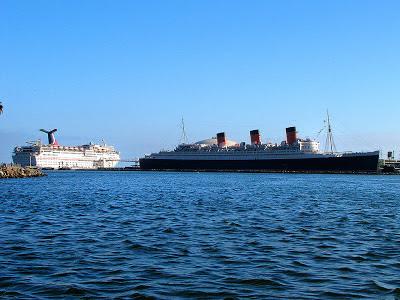 |
| The Ocean Center Building at 110 West Ocean Boulevard |
On the penultimate day of my 2012 visit to America, I went
to Long Beach, California. I had never been there before, and wanting to get
out of downtown Los Angeles, a trip to the ocean seemed just the ticket before
a long flight back to Australia. Here are some snapshots of my visit.
 |
| For Sale? Yes, please. Long Beach, California |
I assumed Long Beach was part of Los Angeles, but it seems
Long Beach is a city in its own right. In fact it qualifies as the 36th-largest
city in the United States, and the seventh-largest in California. In addition,
Long Beach is the second largest city within the Greater Los Angeles Area,
after Los Angeles itself. As of 2010, its population was just over 462,000.
 |
| Parkers’ Lighthouse, Long Beach, California |
Long Beach apparently suffers from some of the worst air
pollution in Southern California and the United States. Thankfully, on the afternoon
I visited, non of this pollution seemed to be in evidence judging by the mostly
cloudless, and ever present bright blue sky.
 |
| Lighthouse, Long Beach, California |
The Port of Long Beach is the United States' second busiest
container port and one of the world's largest shipping ports. Trade valued
annually at more than $140 billion moves through Long Beach, making it the
second-busiest seaport in the United States.
 |
| Carnival Inspiration (left), and Queen Mary (right), Long Beach, California |
The RMS Queen Mary is a 1936 art deco ocean liner
which is permanently docked at Long Beach. Roughly 200 ft (61 m) longer than
the RMS Titanic, the former Cunard Liner is famous for being the fastest
in the world from 1936 to 1952; for its distinctive art deco design, and for
its use during World War II as a troop transport. It was purchased by the city
of Long Beach in 1967, and converted to a hotel and maritime museum.
Unfortunately, I did not have time to get any closer than this view, which is a
pity. As a former ship yard worker, I would have loved the opportunity to go on
board and give the ship a closer inspection.
 |
| The Carnival Inspiration, Long Beach, California |
With the Carnival Inspiration berthed so close to the
Queen Mary, it was a perfect opportunity to make a visual comparison
between the old and new cruise liners. One imagines vast differences between
the layout and facilities of each ship, but both no doubt have their champions,
even today. If you had a choice, which would you prefer to sail on?
 |
| Shopping outlet at Shoreline Village, Long Beach, California |
I did not have time to check out other attractions around
Long Beach, but the 5-acre (20,000 m2) Aquarium of the Pacific is located
nearby, as is the Long Beach Convention Center, and the Shoreline Village,
where these two images (above and below) were taken―as were the two photos
above of Parker’s Lighthouse.
 |
| Waiting for my ship to come in at Long Beach, California |
Downtown Long Beach is located approximately 25 miles (40
km) south of Downtown Los Angeles. I got there by boarding a Metro train
somewhere downtown, and riding it to Long Beach. I enjoyed my visit, although
it was far too brief, and given the chance I would like an opportunity to spend
several days in the area exploring further.
More Information
Thanks to Wikipedia for the background information used in this post. See the full Long Beach Wikipedia entry here...
P.S. Click on the images to view full size.



